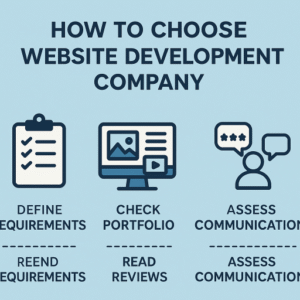A slow-loading page, clunky navigation, or inconsistent layout may seem like minor issues but together, they can quietly damage your brand’s reputation and turn away potential customers. Most of these problems stem from poor website structure or design choices. While online builders offer convenience, they often fall short when it comes to truly optimized, user-centric experiences.
This is where professional web designers come in. With a blend of technical skill and visual sensibility, they can pinpoint design bottlenecks and quickly turn them into opportunities for better user engagement and higher conversions.
Below are nine common website problems that expert web designers can fix often faster than you’d expect.
1. Cluttered or Confusing Layout
First impressions are often visual. If a visitor lands on your site and doesn’t know where to look first, they’re more likely to bounce than stay. A cluttered layout overwhelms users, confuses their path, and diminishes trust.
How web designers solve it:
-
Use of clear visual hierarchy
-
Organized spacing and alignment
-
Consistent styling of headings and content blocks
-
Elimination of unnecessary elements
Clean and intuitive layouts not only improve aesthetics they enhance usability and guide visitors toward action.
2. Slow Page Load Times
If your site takes more than three seconds to load, you’re already losing visitors. Page speed impacts user experience, bounce rate, and even search engine rankings.
Professional web designers know how to:
-
Optimize image sizes and formats
-
Minimize code and third-party scripts
-
Use proper caching techniques
-
Recommend fast, reliable hosting
These performance enhancements drastically improve load times without compromising design quality.
3. Lack of Mobile Responsiveness
More users now browse on mobile than desktop, yet many websites still struggle with layout issues on smaller screens. This leads to poor navigation, unreadable text, and distorted images.
What web designers ensure:
-
Responsive frameworks that adapt to all screen sizes
-
Touch-friendly navigation and buttons
-
Mobile-optimized media display
-
Smooth scrolling and scaling behavior
With mobile-first design principles, web designers create consistent experiences regardless of device.
4. Unclear Navigation Structure
If users can’t find what they’re looking for in a few clicks, they’ll abandon your site. A messy or overcomplicated navigation structure causes friction and confusion.
Web designers bring clarity through:
-
Well-structured menus and submenus
-
Clear labeling of categories
-
Logical content grouping
-
Sticky headers or breadcrumb navigation
A clear and accessible menu is essential to keeping visitors engaged and moving through your site.
5. Inconsistent Branding and Design Elements
Your website should reflect your brand consistently across every page. When fonts, colors, and visuals vary too much, it weakens brand recognition and credibility.
Web designers fix this by:
-
Applying consistent typography and color schemes
-
Aligning imagery and icons with brand identity
-
Creating design systems or brand style guides
-
Auditing and updating older content visuals
Consistency not only strengthens branding it creates a more professional and trustworthy feel.
6. Poor Call-to-Action (CTA) Placement
Your website’s success depends on users taking action whether that’s signing up, making a purchase, or booking a call. If CTAs are buried, vague, or uninspiring, conversions suffer.
How web designers improve CTAs:
-
Placing buttons in high-visibility areas
-
Using action-oriented, clear language
-
Ensuring color contrast and size attract attention
-
Testing variations for best performance
Well-placed CTAs guide visitors toward the actions you want them to take without being pushy.
7. Unoptimized Visual Content
High-quality visuals are crucial for user engagement, but poorly formatted or unoptimized images can hurt load times and design balance. Similarly, a lack of visual hierarchy can make content hard to digest.
A web designer will:
-
Resize and compress images without quality loss
-
Maintain alignment across screen sizes
-
Integrate videos or animations strategically
-
Use visual storytelling to reinforce messaging
When visuals are intentional and optimized, they elevate the overall user experience.
8. No Clear User Journey or Funnel
A user’s path through your site should feel intentional. If pages don’t guide visitors toward a goal, you’ll lose them halfway through their journey.
Web designers help by:
-
Designing user flows from entry to conversion
-
Creating landing pages that serve specific goals
-
Simplifying contact and inquiry forms
-
Integrating trust signals like reviews or badges
Structured journeys turn casual visitors into loyal customers more efficiently.
9. Outdated Design That Feels Behind the Times
A website that looks five years out of date can reflect poorly on your brand even if your services are cutting-edge. Web standards evolve quickly, and users notice.
Signs your site might be outdated:
-
Heavy use of gradients or drop shadows
-
Boxy layouts without responsiveness
-
Clunky fonts or low-quality graphics
-
Broken links or deprecated plugins
Web designers modernize design language while preserving your brand’s identity, making your business look as current as it actually is.
Why You Should Consider Web Designers from India
If you’re facing one or more of these issues, working with a professional can save you time, money, and lost opportunity. But hiring an in-house designer isn’t always feasible for every business.
A great alternative is to work with web designers from India, known for their technical proficiency, creative adaptability, and cost-effective services. Many Indian design agencies and freelancers offer flexible packages, fast turnaround times, and communication standards that match global expectations.
Whether you need a small fix or a full redesign, outsourcing to a reliable team can give your brand the professional edge it needs—without straining your budget.
Want to explore more content like this visit : topbizlists.com



